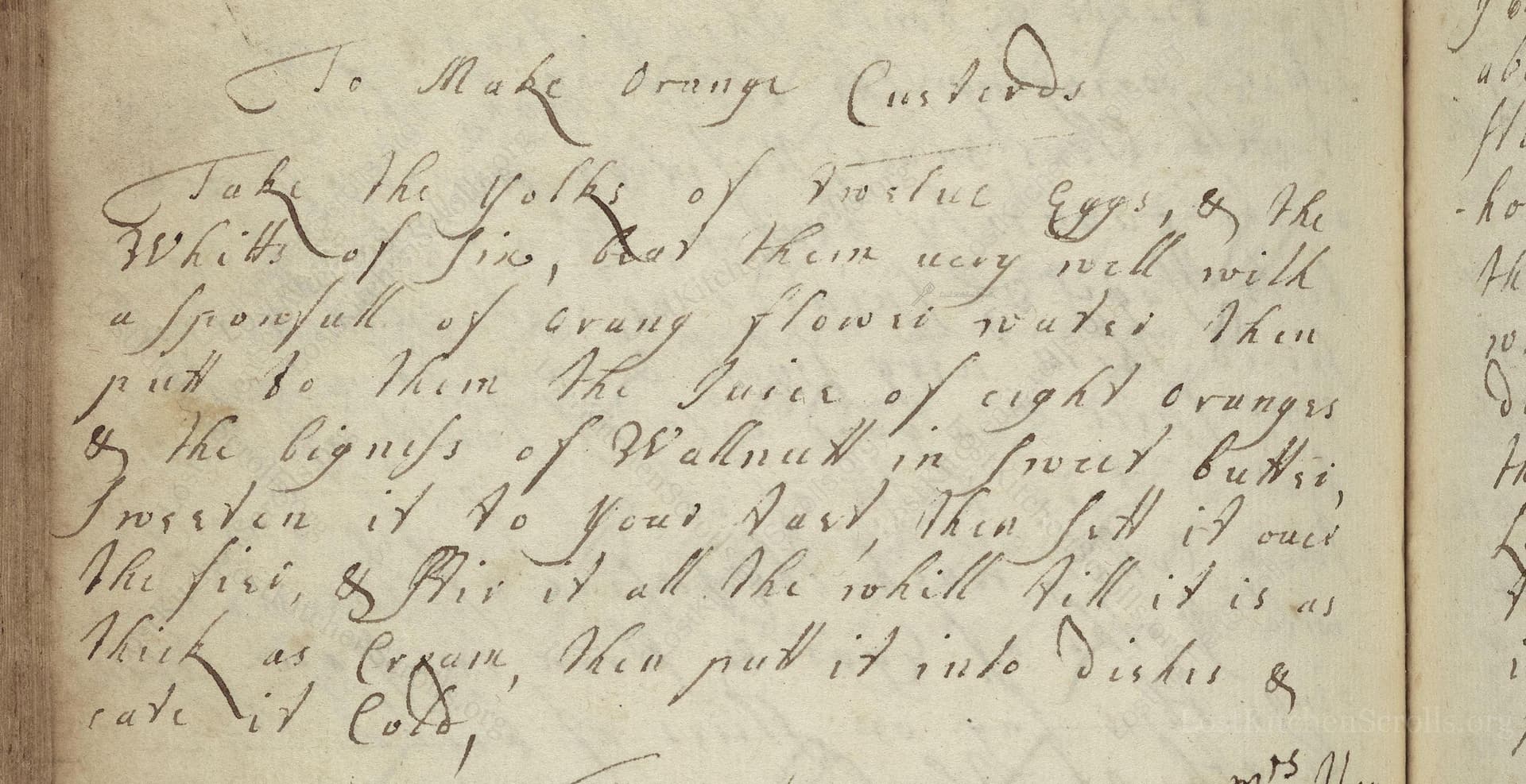To Make Orange Custards
From the treasured pages of Receipt book of Penelope Jephson
Written by Penelope Patrick

To Make Orange Custards
"Take the yolks of Twelve Eggs, & the Whites of Six, beat them very well with a sponfull of orang flower water Then put to them The Juice of eight oranges & the bigness of a Walnut in sweet Butter, sweeten it to your tast, then set it over the fire, & stir it all the while till it is as Thick as Cream then put it into Dishes & eate it Cold,"
Note on the Original Text
The recipe, as was common in its time, omits precise measurements and temperature guidance—assuming a cook's familiarity with such processes. Spelling is variable (e.g., 'sponfull' for spoonful, 'bigness' for size, and 'eate' for eat), reflecting early modern English orthography. Instructions are presented as a continuous flow, with little punctuation, relying on the performative knowledge of the reader rather than on stepwise, detailed directives—a hallmark of early handwritten recipe collections.

Title
Receipt book of Penelope Jephson (1673)
You can also click the book image above to peruse the original tome
Writer
Penelope Patrick
Era
1673
Publisher
Unknown
Background
Step back into the sumptuous kitchens of the late 17th century with Penelope Patrick’s culinary collection—a feast of historic recipes, secret tips, and the irresistible flavors of Restoration England all bound together in a handwritten treasure.
Kindly made available by
Folger Shakespeare Library
This delectable orange custard comes from the late 17th century, penned by Penelope Patrick between 1671 and 1675. It offers a beautiful glimpse into the domestic sophistication of Restoration-era English households, where custards and creams enjoyed great popularity at the table. During this period, the increasing availability of exotic ingredients such as oranges and orange flower water reflected both wealth and evolving culinary tastes. Recipes like this would grace the dessert course of a genteel household, capturing the essence of luxury in a spoonful.

In the 17th century, cooks would prepare this custard using large ceramic or tin bowls, wooden spoons or whisks for mixing, and a brass or copper saucepan for gentle cooking over a wood-fired hearth or charcoal brazier. The mixture was stirred constantly to prevent curdling, and custards were often finished in shallow dishes or delicate glassware, then left to cool naturally on a sideboard or window ledge.
Prep Time
15 mins
Cook Time
10 mins
Servings
6
We've done our best to adapt this historical recipe for modern kitchens, but some details may still need refinement. We warmly welcome feedback from fellow cooks and culinary historians — your insights support the entire community!
Ingredients
- 12 egg yolks
- 6 egg whites
- 1 tablespoon (0.5 fl oz) orange flower water
- 2 cups fresh orange juice (from about 8 oranges)
- 2 tablespoons (1 oz) unsalted butter
- 1/2 cup sugar (or to taste)
Instructions
- Begin by separating twelve egg yolks and six egg whites.
- Beat them together briskly with about one tablespoon (0.5 fl oz) of orange flower water until well combined and lightly frothy.
- Next, juice eight fresh oranges, which should yield approximately 2 cups of juice, and stir this into the egg mixture.
- Add about 2 tablespoons (1 oz) of unsalted butter (roughly the size of a walnut).
- Sweeten the mixture to taste with sugar—start with 1/2 cup and adjust as you wish.
- Place the mixture in a saucepan over low heat, stirring constantly, until the custard thickens to the consistency of pouring cream.
- Be careful not to overheat, or the eggs may scramble.
- Pour the custard into small bowls or dishes and allow it to cool completely.
- Serve chilled for a refreshing citrus treat.
Estimated Calories
215 per serving
Cooking Estimates
You will spend about 15 minutes getting the ingredients ready and another 10 minutes slowly cooking the custard. Each serving has about 215 calories, and this recipe makes 6 servings.
As noted above, we have made our best effort to translate and adapt this historical recipe for modern kitchens, taking into account ingredients nowadays, cooking techniques, measurements, and so on. However, historical recipes often contain assumptions that require interpretation.
We'd love for anyone to help improve these adaptations. Community contributions are highly welcome. If you have suggestions, corrections, or cooking tips based on your experience with this recipe, please share them below.
Join the Discussion
Rate This Recipe
Dietary Preference
Culinary Technique
Occasions

Den Bockfisch In Einer Fleisch Suppen Zu Kochen
This recipe hails from a German manuscript cookbook compiled in 1696, a time whe...

Die Grieß Nudlen Zumachen
This recipe comes from a rather mysterious manuscript cookbook, penned anonymous...

Ein Boudain
This recipe comes from an anonymous German-language manuscript cookbook from 169...

Ein Gesaltzen Citroni
This recipe, dating from 1696, comes from an extensive anonymous German cookbook...
Browse our complete collection of time-honored recipes



